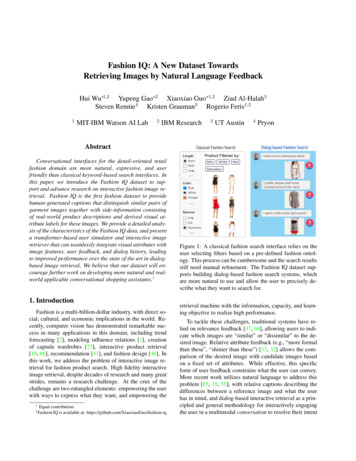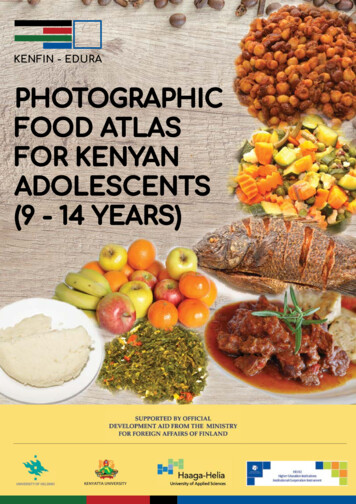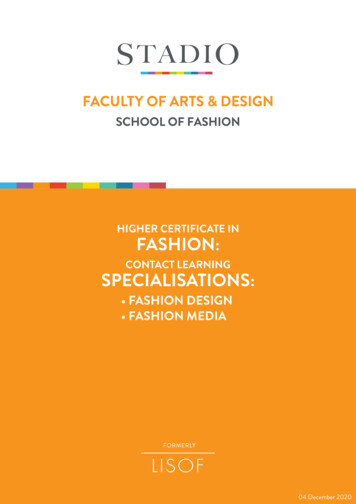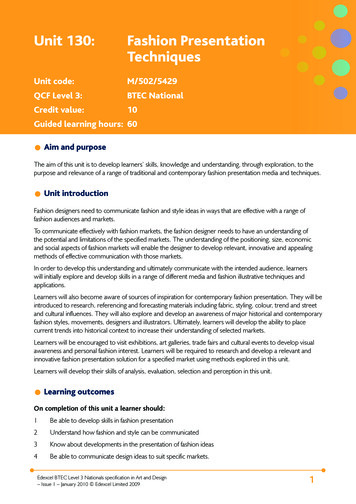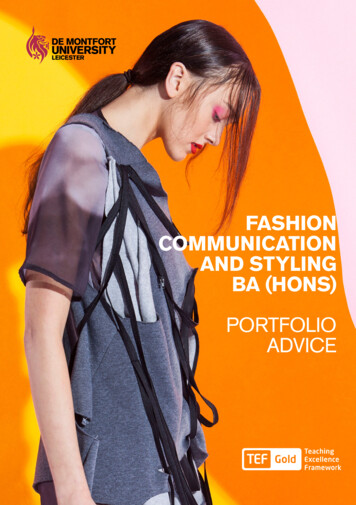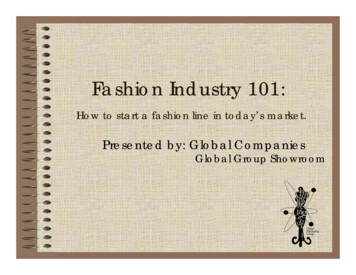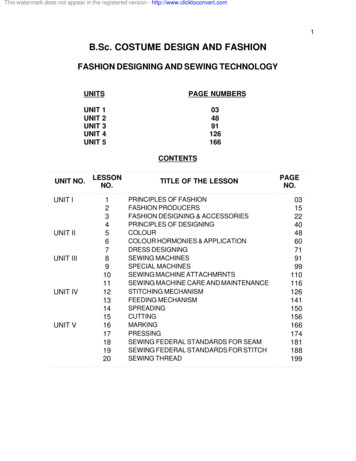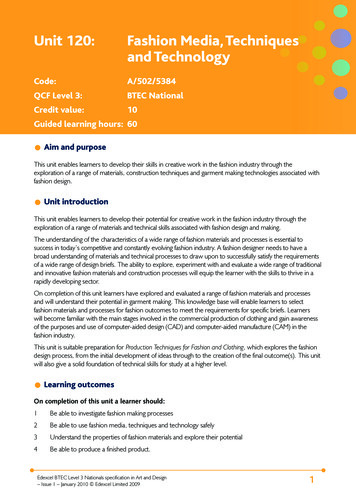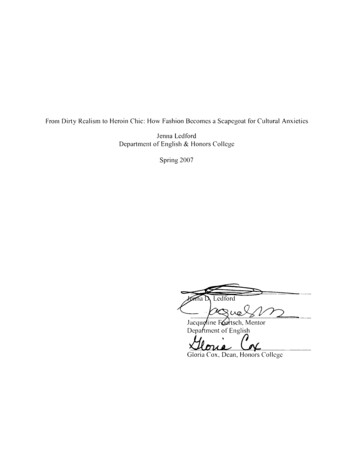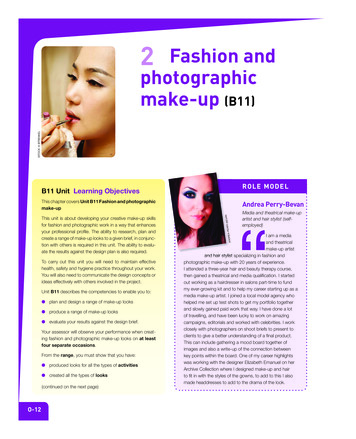
Transcription
2ISTOCK: BTRENKELFashion andphotographicmake-up (B11)R O LE MO DELB11 Unit Learning ObjectivesThis chapter covers Unit B11 Fashion and photographicmake-upTo carry out this unit you will need to maintain effectivehealth, safety and hygiene practice throughout your work.You will also need to communicate the design concepts orideas effectively with others involved in the project.Unit B11 describes the competencies to enable you to: plan and design a range of make-up looks produce a range of make-up looks evaluate your results against the design brief.Your assessor will observe your performance when creating fashion and photographic make-up looks on at leastfour separate occasions.From the range, you must show that you have: produced looks for all the types of activities created all the types of looks(continued on the next page)O-12VANPERRY-BEANDREAThis unit is about developing your creative make-up skillsfor fashion and photographic work in a way that enhancesyour professional profile. The ability to research, plan andcreate a range of make-up looks to a given brief, in conjunction with others is required in this unit. The ability to evaluate the results against the design plan is also required.Andrea Perry-BevanMedia and theatrical make-upartist and hair stylist (selfemployed)“I am a mediaand theatricalmake-up artistand hair stylist specializing in fashion andphotographic make-up with 20 years of experience.I attended a three-year hair and beauty therapy course,then gained a theatrical and media qualification. I startedout working as a hairdresser in salons part-time to fundmy ever-growing kit and to help my career starting up as amedia make-up artist. I joined a local model agency whohelped me set up test shots to get my portfolio togetherand slowly gained paid work that way. I have done a lotof travelling, and have been lucky to work on amazingcampaigns, editorials and worked with celebrities. I workclosely with photographers on shoot briefs to present toclients to give a better understanding of a final product.This can include gathering a mood board together ofimages and also a write-up of the connection betweenkey points within the board. One of my career highlightswas working with the designer Elizabeth Emanuel on herArchive Collection where I designed make-up and hairto fit in with the styles of the gowns, to add to this I alsomade headdresses to add to the drama of the look.
O-13CHAPTER 2 (B11) FASHION AND PHOTOGRAPHIC MAKE-UP(continued) addressed all the resource needs involved at least two of the seven relevant persons* used all the make-up application techniques considered all of the additional media*.*Note: For these particular units, knowledge evidence neednot be produced for the remaining items in the range.It is likely that most evidence of your performance will begathered from the observations made by your assessor, butyou may be required to produce other evidence to supportyour performance if your assessor has not been present.When designing and creating images for use in fashionphotographic contexts, it is important to use the skills youhave learnt in the following core mandatory units:G22 Monitoring safe work operationsH32 Promotional activitiesFashion and photographicmake-upThe world of the fashion and photographic make-up artist is an exciting and everchanging one. It is of the utmost importance to keep up-to-date with current fashionand trends. What may be fashionable one season can change the next, and quickly lookoutdated. You can produce some looks which are classic and never really date, or designhigh-fashion images which will look terrific on a professional model, but not as good on amember of the general public as a special occasion make-up.You must understand the subtle differences used in creating make-up looks for bothcolour and black and white photography and the effect distance and lighting has onfashion shows. You will create a range of period-inspired looks and need to use yourimagination and artistic skills to create fantasy and high-fashion effects. Commercialmake-up is created for advertising purposes and must not detract from the subject/medium being advertized, while bridal make-up must suit and please the individualwearing it, as well as looking great for photographic purposes. The stages for fashionand photographic make-up activities will always be similar, although the techniques andfinished effects can be quite different. Your work in this area will include make-up looksfor photographic shoots, catwalk shows, music videos, commercials, bridal and specialoccasion make-ups.JO CROWDERYou must work closely with the other people involved in the process so you all worktowards, and aim for, the same agreed end result. Detailed and accurate planning isimportant so that no misunderstandings and subsequent waste of resources includingtime and money.Bridal make-up
O-14LEVEL 3 PROFESSIONAL BEAUTY THERAPYOutcome 1: Plan and design a range of make-up looksB11 Plan and design a range of make-up looks by:1 agreeing contractual arrangements with the relevant person(s) prior to commencingyour design plan2 clearly identifying the intended activities for which the make-up is required3 using suitable sources of information to research ideas on themes for design4 accurately sourcing and using suitable information to create your design5 creating a design plan which: has clearly defined objectives which meet the client’s brief contains mood boards suitable for the look(s) required takes account of budgetary constraints defines all resources required states how any risks to health and safety can be reduced takes account of foreseeable problems and ways of resolving them takes account of lighting requirementsTOPT IPIf you are in a dingycorner without natural daylight, ask the photographerto set up some extra lights toilluminate your model’s facewhile you are working.HEALTH& SAFETY Recognize potential hazards inthe workplace and warn othercolleagues and clients of them. Recognize steps that canbe taken to minimize the riskof injury and infection at anymake-up activity.ACTI V I TYCheck how and if legislation andlocal bye-laws will restrict or limityour use of products, tools andequipment where you are working. takes account of additional media agreeing your design plan with the relevantperson(s) Preparing the working environmentPreparing the working environmentMake sure you are prepared, have everything you could possibly need, and that your kit isclean and well organized. When you arrive at the studio there may or may not be a designatedarea for make-up application. Most good studios have an area with seating and a make-upmirror; others can be less than ideal and you just have to make the most of what you have.Make sure the area is safe, comfortable and clean before you lay out your equipment.“At the end of a day, I always make sure that my kit is clean and readyfor the next job, as you can easily have a last minute call out. Alwaysarrive at a job looking presentable and professional.Andrea Perry-BevanWhen you have finished your make-up, you will need to keep a few products on hand,such as powder and a powder puff, cotton buds, tissues and lip colour required to maintain the make-up look. For changes of costume and make-up, you should be able to takeyour model back to the designated make-up area.If on location you must make the most of the environment you are in. Try to keep make-upat a regular temperature, so it does not freeze or melt. A cool bag is a good place to storeyour make-up. If working in windy conditions, make sure your make-up box has a lid, so itdoes not end up full of sand or leaves, dependant upon the location. Set bag, as used whenfilming (see Online Chapter 4 TV, film and special effects make-up), is very useful whenon location, when you need to find products quickly. Some products can be decanted ortransferred into plastic bottles, which can reduce breakages, especially on flights. Becauseof added security at airports and the ban on liquids in hand luggage, it is best to put make-upkits in the hold, just make sure your box/bag is sturdy enough to avoid damage.
O-15By talking to the client, photographer, fashion editor, fashion designer, etc. you shouldget a pretty good idea of what they are looking for. You may need to do some sketches,worksheets, and a mood board, which presents your ideas, or discuss what they andyou have in mind for the overall look. You may need to research extensively for the shoot,using references such as magazines, books and the Internet. You must communicateyour ideas effectively with the others before you agree to a final design plan and have yourwork checked over again at the end. The make-up look/s must then be checked underthe final lighting and on the set, using props if required.On a large shoot or show you will invariably work with other colleagues and take instruction from your line manager. Distance and lighting need to be taken into considerationto please the relevant people viewing your work, for example, consider the differencesbetween make-up competition judges who will scrutinize your work in close up, or audiences at a catwalk show who will view work from a distance – usually under stronger andcoloured lighting effects.JO CROWDERMood boardBEST PRACTICE Make sure you agree all contractual arrangements prior tocommencing the design plan.These must be realistic. Specify resource needsaccurately and stay within yourbudget.MAKE-UP BY SARAH PERRY, PHOTOT BY LYNSEY ROBERTS/LIVERPOOLPreparation of equipment, materialsand productsMake sure you have acquired any relevant props, make-up and hair equipment before youarrive at the job. If you need any other additions to your kit, allow plenty of time to sourcethem, contacting suppliers. Make-up products and equipment can be sourced from professional make-up suppliers and department stores. Additional items such as gold leaf,lace, feathers, gems, etc. can be sourced from art, haberdashery and fabric stores.You may wish to take your own Polaroid photographs, although most good photographerswill use them to check the lighting effects anyway, and then pass them to you to checkmake-up and hair. The use of digital cameras is becoming more widespread, enablingyou to see results instantly. Always check with the relevant people that you will have theresources you need such as good lighting, seating, a mirror if possible and space to work.If you have any problems at all, do not ignore them hoping they will go away, but communicate with the relevant people your concerns and requirements as soon as possible.Spring Fairy make-upTOPT IPEffective communication Always be respectful and aware of differences in culture, age, disability andgender. Always strive where practicable to meet the needs of your clients. During meetings/consultations be aware that time equals money – donot waste time on irrelevant things, but concentrate on the purpose ofthe meeting and planning the job effectively. Listen carefully to others, communicate your own ideas, take on boardfeedback and be prepared to make changes. Understand the importance of confidentiality. At the end of a meeting or consultation with a client, summarize keypoints and confirm your understanding of what has been discussed.“Always make sureyou give yourself plentyof time to get to a jobin case of unexpected incidents onthe way. Being late for an importantclient is not an option. If I need todrive for more than 3 hours to getto a job, I leave up to 1 hour earlierthan usual to ensure that I am notlate.Andrea Perry-BevanCHAPTER 2 (B11) FASHION AND PHOTOGRAPHIC MAKE-UPBe aware that the client may not have been on a shoot before. Advise them about healthand safety, and any potential danger areas in the studio or on location. Items such astrailing cables, light boxes, stands and reflector boards are all hazards that you must lookout for. You must be aware of legislation and any local bye-laws that are likely to affect youand make sure you are adequately insured.
O-16LEVEL 3 PROFESSIONAL BEAUTY THERAPYFashion and photographic make-up timingsBEST PRACTICETimes will vary from 15 minutes for make-up for a catalogue shoot where make-up isphotographed from a distance to an average of 30 minutes for the majority of make-up,through to an hour or more for cosmetic shoots where make-up is photographed inextreme close up, or for very elaborate fantasy make-up effects. Sometimes you willbe asked how much time you require to complete a particular make-up and on otheroccasions you will be told that you have so long to achieve the design brief.If you anticipate any problems completing make-up in the allocatedtimes, speak to your line managerimmediately before it leads to bigger problems! Always be realistic.When more than one model/client/artiste is involved, you will need to follow a runningorder. For example, in bridal work you may have make-up, hair and manicure for the bride,plus the same for three bridesmaids and the bride’s mum. Careful planning and regular‘time checking’ will be necessary so the bridal party arrives at the church on time.For catwalk shows you will be given a running order which will contain details of start and‘on stage’ times, plus the number and names of models and changes of clothing. Youmust be able to interpret this and keep on top of your designated work in an extremelybusy environment.For commercials, depending on the number of people involved, a call sheet similar tothose given in the TV and film industry can be given for you to follow.In photographic work, it is preferable for the photographer to shoot in colour first, thenask you to make possible alterations to the make-up for the black and white shots,by adding extra contouring and highlighting and perceiving how the colour shades willregister on the black and white scale and making amendments where necessary. Thisshould take between 2 and 10 minutes depending on how suitable the original colourphotographic make-up is.ALWAY SRE M EMBER When finalizing a running order for a wedding, it is a good idea to allow extra time withinthe schedule for interruptions – flowers arriving, telephone calls, etc. If using electrical equipment such as airbrushes or hairstyling equipment, compliant withrelevant health and safety regulations, make sure equipment is serviced every 12 monthsby a qualified electrician and you have access to spares just in case! If you are responsible for providing a number of make-up artists for an event, try to keepsomebody in reserve in case of illness, etc.Roles and responsibilities of other relevantpeople Photographer – takes the photographs using a camera. Photographer’s assistant – sets up for the photographs, holds reflectorCatwalk make-upboards, takes light readings and carries the equipment. They are responsible foranything involving camera equipment. The client – commissions the shoot/show. Occasionally they may not bepresent, or to the other extreme, they may bring an entourage or team ofadditional people with them. The client can also refer to the person on whomyou are working.
O-17CHAPTER 2 (B11) FASHION AND PHOTOGRAPHIC MAKE-UP Art director – is in overall charge of the visual appearance and how itcommunicates to the target audience. They come up with the visual concepts forthe design brief and communicate with everyone else involved in the process toensure the ‘vision’ is realized. Make-up designer – responsible for designing, creating and maintaining themake-up. The designer may have a group of make-up artists and/or make-upassistants present to help out on large shoots, weddings or shows. Hair designer – designs, creates and maintains the model’s hairstyle(s).Sometimes there can be many changes throughout the day. The make-updesigner may have assistants to help on large jobs. Fashion stylist – selects the clothing and accessories, dresses the model, andchecks that the clothing ties in with the overall look to meet the design plan. Nail technician – responsible for enhancing the image of the nails. Theymay perform services such as manicures, artificial nails and decorative nail arttechniques.Adding finishing touches to the hair Model – changes poses and models clothing, make-up and hair. Essential, asyou would not have the work without them! Artistes – people on whom you are working such as musicians, dancers andactors.All of the above people work closely together to finalize the image. It is important to note thatsometimes the make-up artist can also be responsible for the hair and styling. This dependson budgets (which should be decided and agreed prior to the shoot) and the size of theshoot.MAKE-UP BY JO CROWDERDepending on where in the world this all takes place, you may have a location guide andinterpreters who travel with you too.ALWAYSR EM EMB E R Remember your role and do not step into other colleague’s roles unless asked to do so.You would not like it if someone else came to alter or mess with your work!“Be adaptable with the team or client you will be working with asmany times you will be asked during the job for feedback on how youcould improve on the initial brief.Andrea Perry-BevanOutcome 2: Produce a range of make-up looksB11 Produce a range of make-up looks by:1 preparing the work environment to meet legal, hygiene and applicationrequirements2 preparing suitable equipment, materials and products for the make-upapplicationFashion shootTOPT IPIf you are trainedand proficient in hairstyling, fashion styling and/or nails, your chancesof obtaining work willbe increased, especiallyfor smaller assignmentsor where the budget islimited, as the client onlyhas to pay one fee to oneperson. It pays to enhanceyour skills.
O-18and minimizes the risk of injury to both of you4 identifying any contra-indications or restrictions to the make-up application5 using suitable make-up application techniques for the agreed design brief6 accurately applying false lashes to enhance the final design look, if required7 managing resources within the limits of your own authority8 communicating effectively with relevant person(s) throughout the make-upactivities9 adapting your agreed design plan to meet any changes to the original brief10 ensuring the use of resources conforms to the design planMAKE-UP BY ALISON SMITH, PHOTO BY LYNSEY ROBERTS/LIVERPOOL11 ensuring the finished make-up look(s) meets the design briefWorking to a briefIf you need any special resources, make sure you have budgeted for them and make sureyou are able to adapt the design plan if any circumstances change. Give out accurateinformation to others, making sure it is clear, and delivered at a pace and manner suitablefor the event. You could be working on a catwalk show where time is limited and you needto get over information calmly and quickly, having to interrupt someone else. Make sure youapologise for interrupting. It is very important that you communicate and work closely withthe rest of the team so that no misunderstandings take place and the overall design plan isrealized.Ice Queen in colour, with use of additionalmediaCheck that the use of your resources conforms to the design plan, and use additionalmedia wherever possible to enhance the image and complement it, such as paintingnails to colour coordinate, along with clothing, accessories (props, headdresses, jewellery) and hairstyling. Carefully chosen accessories can really improve the look of theoverall shot.Designing and developing imagesMAKE-UP BY ALISON SMITH, PHOTO BY LYNSEY ROBERTS/LIVERPOOLLEVEL 3 PROFESSIONAL BEAUTY THERAPY3 ensuring the person on whom you are working is in a position that permits accessWhen you create an image it is often advertising something, e.g. jewellery or clothing, andthe make-up should not distract from whatever you are selling. In an advertising makeup, do not distract from the subject of the advert with too many other fussy accessories.Also consider design, scale and proportion. As the shoot progresses, you may see anopportunity for developing the initial image slightly. Check with the rest of the team beforeyou go ahead and change anything.“When I am working and I see something obvious that needs tobe attended to, I won’t wait to be asked as other team membersmay not see what I see, as they are concentrating on the many otherelements of the shoot.Ice Queen photographed in black and whiteAndrea Perry-Bevan
O-19 Always ask the client if they have any known allergies to cosmetic products. Perform a skin sensitivity patch test if you have any doubts if using special effectsmake-up, or are using non-cosmetic products such as gold leaf. Become familiar with ingredients in skincare preparations and make-up products andtheir purpose. Be up-to-date with health and safety cosmetics data. Look out for certain syntheticcolours like FD&C red no.6 and D&C green no.6 which should not be used too close tothe eyes or on the lips. Use products intended for their purpose, e.g. don’t use chunky glitter intended for useon paper near someone’s eyes as it will be very abrasive. Only use cosmetic gradeglitters.MAKE-UP BY JO CROWDERBEST PRACTICEFantasy make-up for cosmetic promotionYou may need to interpret a theme, e.g. an icy winter scene could imply using colourssuch as silvers, blues, greys and white. Or the client may want a make-up designed inbrighter colours to ‘warm up’ a winter’s day.Consider the use of other components apart from the make-up, which will be visibleand enhance the overall image. These items are referred to as ‘additional media’ andinclude: clothing hair nailsMAKE-UP BY JO CROWDER accessories and props.HEALTH& SAFETY Check your client for contra-indications. If they have the skin disorder herpes simplexfor example, use disposables or their own brushes accompanied with hygienicpractices, as you cannot cancel a shoot or wedding because of this! Use hygienic practices – wash hands regularly, and use antibacterial hand cleanseror disposable tissue cloths when on location, use clean gowns, disposable gloves ifworking on someone with contra-indications, keep tools and equipment clean andsterile, never dip tools straight into make-up – remove with a spatula, wipe downworking areas with anti-bacterial cleaner. Try and keep an aseptic working environment.A work situation trying to eliminate bacteria. If contra-actions occur, an unwanted reactions from the products, carefully removemake-up immediately and advise your client to seek medical advice if symptomspersist.Natural make-up for cosmetic promotionCHAPTER 2 (B11) FASHION AND PHOTOGRAPHIC MAKE-UPProducts can be adapted to suit effects required, for example you may wish to dilutea creme foundation to make it into a tinted moisturiser, and lipstick could be used oneyelids, etc.
O-20LEVEL 3 PROFESSIONAL BEAUTY THERAPYTerminology for make-up techniquesTermMeaningPossible areas of applicationPrecision baseapplicationApplying foundation or concealer in an exactmanner to precisely the areas that need it and notnecessarily over the whole face or body, in order toeven out the skin tone.On the face or body over areas of redness,under the eyes, outer corner of the eyes andmouth, around the nose, and over blemishes.HighlightingEmphasizing cheekbones and other features usinga colour at least two shades lighter than the base.Use alongside shading to correct, contour andilluminate areas of the face. Highlighters can bematte or shimmery.To the areas where the natural light hits theface such as the top of the cheekbones, browbones, above the cupids bow on the toplip and so on. Can be used on the body toemphasize muscles and cleavage.ShadingApplying a darker colour to cast a shadow.Shaders are at least two shades darker than theskin tone can be used to contour and correct faceshapes.To soften a square jaw line, disguise a doublechin, straighten a crooked nose and toemphasise the appearance of cheekbones.ConcealingHiding areas with a highly pigmented productwhich is designed to blank out and cover.Over any blemishes, areas of redness and todark shadows under the eyes.BlendingTo mix and/or combine something with somethingelse, e.g. base and natural skin tone or blendingeye shadow colours.Blending base into the hairline and down theneck, or blending one colour into another, as inblusher or eye shadows.StipplingMarking the surface with small dots or specks,providing a decorative or blending effect when replicating natural skin tone. Stipple sponges, regularsponges, brushes or an airbrush can be used.Various, including over areas where camouflage make-up has been applied. A stipplesponge and at least two foundation colourswill help mimic and blend the make-up into thesurrounding skin.Precision applicationof eye productsApplying eye products to precisely the areas thatneed it, with accuracy and exactness, payingattention to detail.On and around the eye areaPrecision applicationof lip productsPaying attention to detail in an accurate and exactmanner, in order to correct uneven lip shape orcreate a different lip shape, e.g. in the creation of aperiod make-up.On and around the mouth/lip area. A sharpened lip liner is generally the easiest way toachieve precision.Colour mixingCombining colours to create a new colour.Anywhere on the face, hair or body.StencillingUsing a thin sheet of acetate, card or other flexiblematerial, onto which a design has been cut out, totransfer an outline or image onto the skin.On the body, hair or face. Stencils can beused in the quick creation of body/face artand tattoos. Also used in airbrushing for theeyebrows and lips.Body make-upApplying liquid or cake make-up to even out theskin tone, or for fantasy effects in body painting.All areas of the body that are going to be seen.How to apply studio make-up1 Make sure your working area is comfortable, clean and hygienic for your client.2 Wash your hands or use disinfectant hand gel, gown up your client to protecttheir clothing and fold tissues around the collar line.
O-21CHAPTER 2 (B11) FASHION AND PHOTOGRAPHIC MAKE-UP3 Check for contra-indications; assess yourclient’s skin type, tone and face shape.4 Choose skincare products according to skintype. Cleanse, tone and moisturise the faceand neck. Apply any eye cream, primers andmatifying (anti-shine) products at this stage.5 Using the principles of colour theory, colourcorrect areas as and where necessary, e.g. usegreen to counteract any redness and yellowtoned concealer for under eye shadows with apurple hue.6 Choose a foundation shade by first testing it alongthe jaw line where you can clearly see the rest of theface and the neck. Decide whether the skin toneis cool, warm or neutral, and then pick a shadethat complements the surrounding skin. On darkerskins there can be more variations between lightand dark, so choose something medium, hencedarkening light areas and lightening dark parts.7 Apply foundation with a sponge or foundationColour wheelbrush, blending into the hairline and down the neck.8 Apply any cream-based highlighting and shading products to correct, contourand illuminate areas of the face.9 Apply concealer over any blemishes, areas of redness and to shadows under the eyes.10 Apply translucent powder to set the base using a powder puff. Pay particularattention to the ‘T’ zone area where the make-up will deteriorate first. Brush offexcess using a powder brush.11 Apply powder blusher using a blusher brush. If you want to use a cream or gelblusher, apply it before the powder stage. This can be applied to the apples ofthe cheeks for a very natural blush effect and/or along the cheekbones.12 Brush through the eyebrows and fill in any gaps with a sharpened eyebrow pencilor powder eye shadow. Eyebrow gel will smooth down any stray hairs and keepthem in place.13 Apply eye shadow colours with precision. Use various sizes of brushes accordingto the area involved and the colours. If using strong or dark colours, you can applya dusting of loose powder under the eyes, on top of the cheekbones to catchspeckles of eye shadow.14 Apply eyeliner using a brush or pencil along the eyelash line, as close as you canto the base of the eyelashes.15 Brush mascara onto the eyelashes, coating each eyelash from base to tip orpoints. Use a clean wand to separate the eyelashes. If you are using an eyelashcurler, use the traditional type before mascara application and the heated varietyafter the mascara has dried. Heated eyelash curlers are like a mini hot brush andare much less evasive for the client.16 Apply artificial eyelashes if the design brief requires them. Strip or individual flareeyelashes can be chosen for a wide variety of effects.Heated eyelash curler
O-22LEVEL 3 PROFESSIONAL BEAUTY THERAPY17 Apply lip liner to outline the lips and prevent the lipstick from ‘bleeding’ into thelines around the mouth. Corrective work may need to be done at this stage toachieve a precision lip line according to the design brief.18 Apply lipstick, stain and/or gloss.19 Add any finishing touches such as glitter, gems, gold leaf, etc. Stencils can beused in the quick creation of body art along with water-based make-up, tattooinks or airbrush products.20 Check the overall result with the design plan and make amendments asnecessary.TOPT IPTips for working with foundation make-up Dilute foundation with a little moisturiser for effects where very littlebase is required and for blending down the neck. Depending on the design brief, if a model has great skin, apply foundation only to areas that need it instead of over the whole face. The heavierthe make-up, the quicker it will deteriorate. Use a liquid body make-up or cake make-up for areas of the body that willshow on film. This is especially important if the photographer is using a digital camera as any imperfections on the skin will stick out like a sore thumb! If using a camouflage make-up product to cover any scars, tattoos, etc.make sure for your final coat you use a stipple sponge and at least two foundation colours to help mimi
FASHION AND PHOTOGRAPHIC MAKE-UP Fashion and photographic make-up The world of the fashion and photographic make-up artist is an exciting and ever-changing one. It is of the utmost importance to keep up-to-date with current fashion and trends. What may be fashionable one season can change the next, and quickly look outdated.File Size: 1MB
